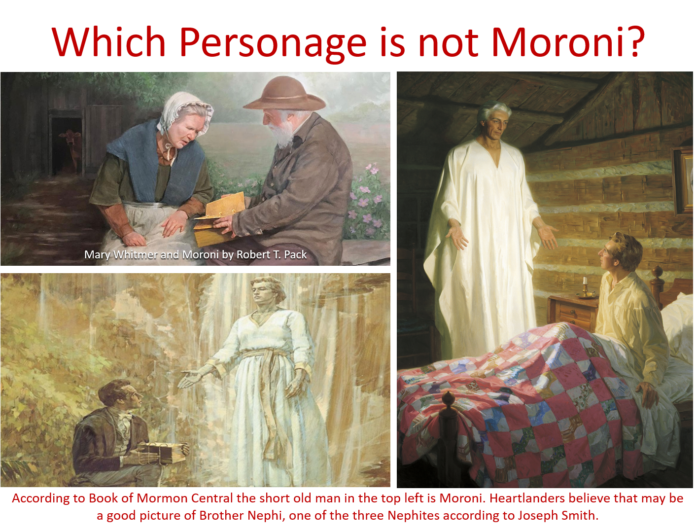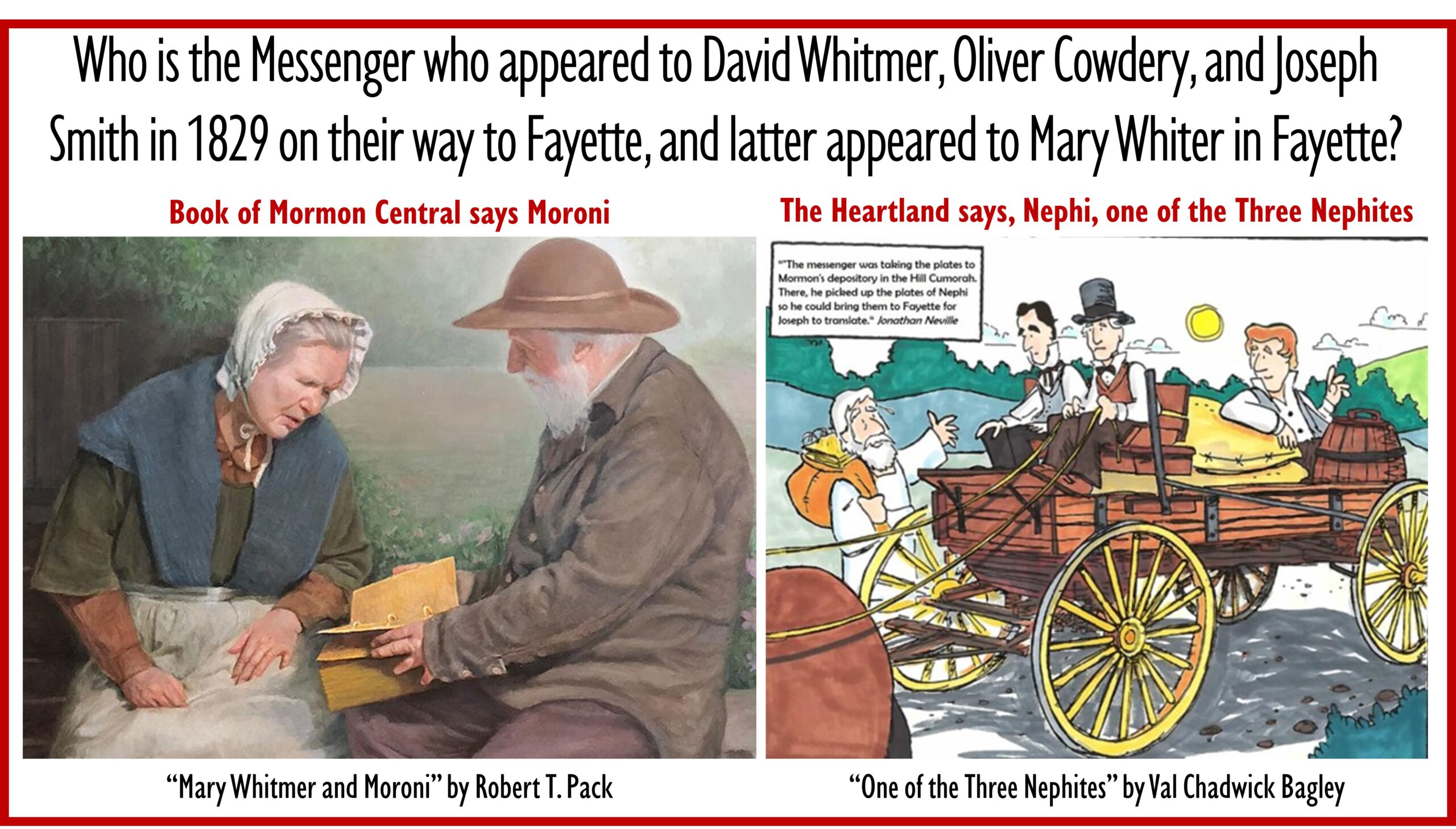
You can read all the quotes yourself below. It makes sense the answer to me is, the man who appears at the wagon carrying the knapsack on his back, was one of the Three Nephites, probably named Nephi. David and his mother Mary gave very similar descriptions at different times which is very conclusive to me.
John C. Whitmer’s 1878 account
As recorded by Andrew Jenson (see his Latter-Day Saint Biographical Encyclopedia 1:283, Salt Lake City, Utah: 1901):
“I have heard my grandmother (Mary Musselman Whitmer) say on several occasions that she was shown the plates of the Book of Mormon by a holy angel, whom she always called Brother Nephi.
Edward Stevenson Accounts
“And an aged man about 5 feet 10, heavy set, and on his back an old fashioned army knapsack strapped over his shoulders and something square in it, and he walked alongside of the wagon and wiped the sweat off his face, smiling very pleasantly. David asked him to ride and he replied, ‘I am going across to the Hill Cumorah.’ Edward Stevenson, Journal, Dec. 23, 1877 quoted in Richard L. Anderson, Investigating the Book of Mormon Witnesses (Salt Lake City, UT: Deseret Book, 1989), 30.
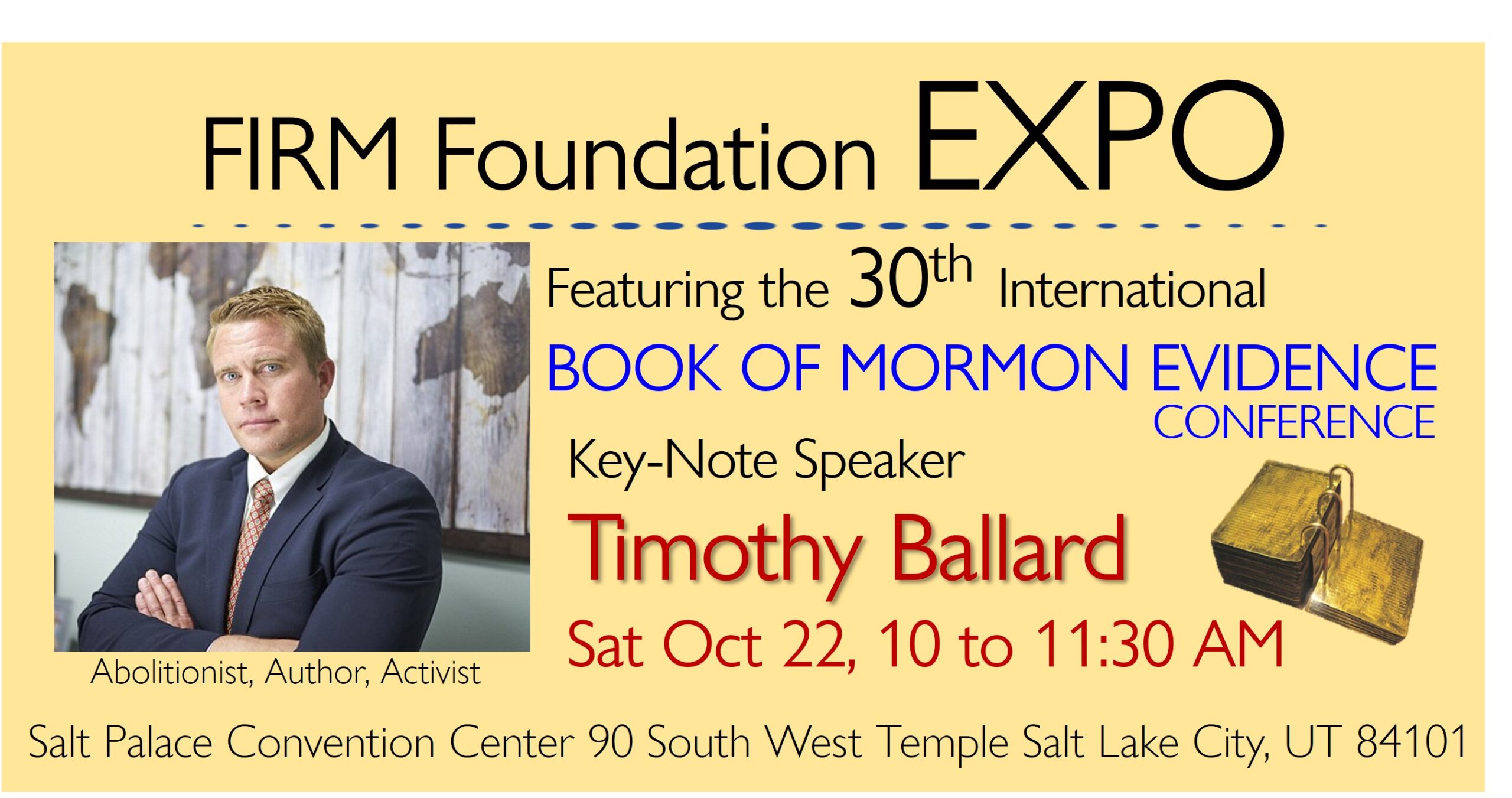
“I wish to mention an Item of conversation with David Whitmer in regard to Seeing one of the Nephites, Zina Young, Desired me to ask about it. David Said, Oliver, & The Prophet, & I were riding in a wagon, & an aged man about 5 feet 10, heavy Set & on his back, an old fashioned Armey knapsack Strapped over his Shoulders & Something Square in it.” “Edward Stevenson Interview (1) 22-23 December 1877, Richmond, Missouri Diary of Edward Stevenson,” LDS Church Archives, Lyndon W. Cook, ed., David Whitmer Interviews, 1993, p. 13; also Dan Vogel, ed., Early Mormon Documents, 2003, vol. v, p. 30
Anita Murdock Account
The reason she was interested in the Three Nephites, is because the same one stopped by their family home in Watertown, Jefferson, NY and taught them the gospel of Jesus Christ…
The family was having what we might call a family home evening one night, discussing scriptures and playing music, when they had a knock at their door, and when opened, they found a man dressed in old fashioned clothes, who said that he usually takes sequestered paths…
Joseph confirmed it was one of the three Nephites sent to prepare them to receive the gospel. Since Zina had spent an entire evening with one of the three Nephites, not a moment, but an entire night learning from him, you can imagine why she was so interested in this story. -Anita Murdock
David Whitmer Account
“It was the messenger who had the plates [of the Book of Mormon], who had taken them from Joseph just prior to our starting from Harmony” David Whitmer to Elders Orson Pratt and Joseph F. Smith in 1878 and in Andrew Jensen, Historical Record, p. 209), and in 1950 Revised Edition of the Doctrine and Covenants Commentary page 508
Jonathan Neville’s Account
“The simplest, historically justified explanation is that David told Zina and her family the story when he contacted them as a missionary. Zina remembered it and told Stevenson to ask David about it in 1877. Stevenson recorded it and wrote about it.” Jonathan Neville
Who is the messenger spoken of? One of the Three Nephites!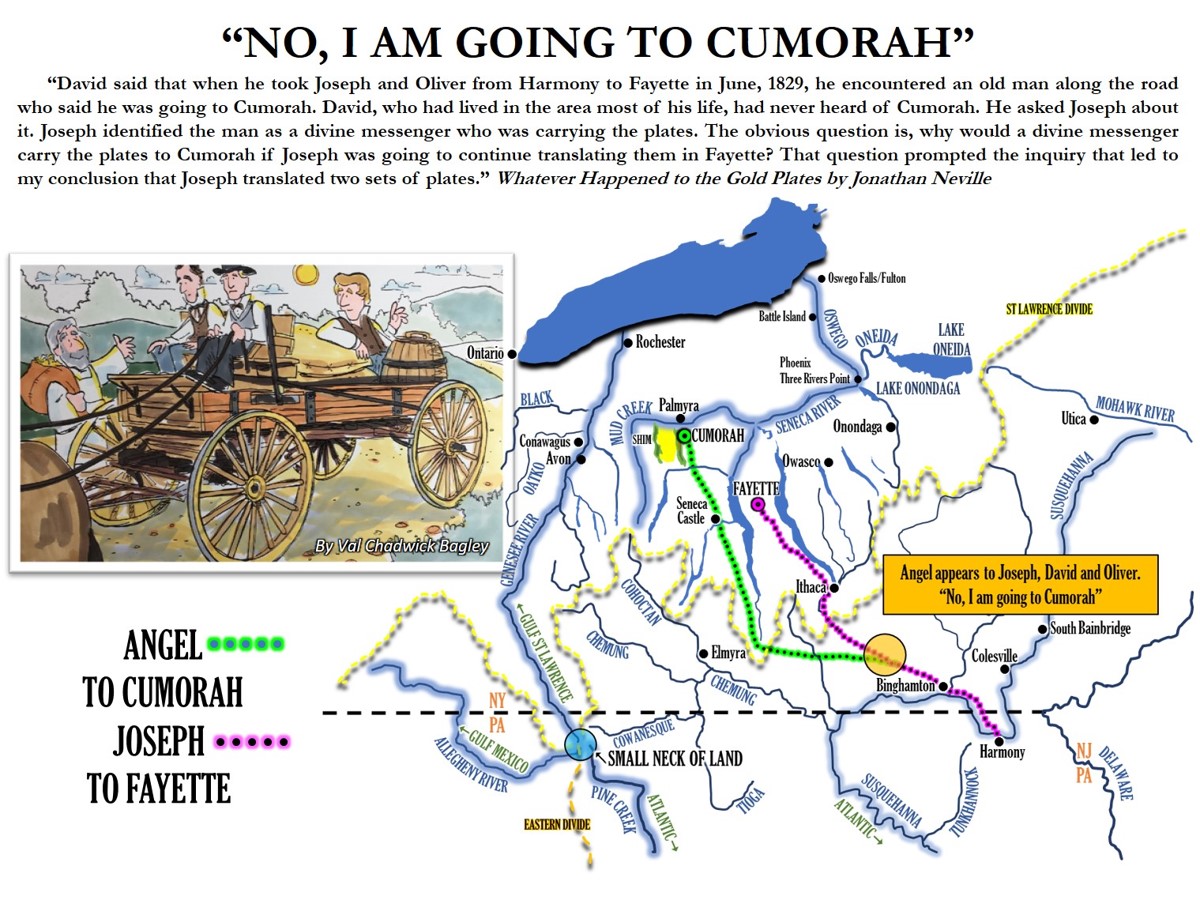
I have studied this part of Church History very thoroughly and I know Rod and Jonathan have as well. The story about the “messenger” who appeared at the Whitmer wagon with Joseph and Oliver riding, on their way to Fayette, and the story about the “Cave at Cumorah” that Joseph Smith entered many times. Both stories scream out truth which validates that Book of Mormon events happened in North America in my opinion.
Editors Account
These two stories make the events of the Book of Mormon happening in Mesoamerica as not likely. Showing two repositories of records at Hill Cumorah is significant. One depository is the Stone Box where the original gold plates were found by Joseph Smith, and a second depository in a different location in Hill Cumorah where wagons full of records were found. In this large cave was also the Sword of Laban and the Liahona which were not found with the gold plates and the Urim and Thummim. Both of these accounts have been published in Church History since 1923 in the Doctrine and the Covenants Commentary shown below.
If the Cave at Cumorah really existed (which it did, see page 47 Doctrine and the Covenants Commentary), there would be no reason for Moroni to walk all the way from Mesoamerica to NY to deposit the plates. In fact think about it. If there was a cave at Cumorah with wagon loads of plates (all Nephite and Jaredite records) and the sword of Laban and the Liahona, how would Moroni bring all of this back to the hill Cumorah in New York? Would he have made 5 or 6 trips of over 3,000 miles each way? My friend Val Chadwick Bagley illustrates that idea below that I asked him to draw. Before he drew the picture he believed the Meso story, but was soon converted after realizing the absurdity of these many trips to Mesoamerica and back to NY.

Historical Information from Church History
The First Presidency in 1923 of Heber J Grant, Charles W. Penrose and Anthony W. Ivins and again in 1950 The Publication Committee of Joseph Fielding Smith, Harold B. Lee and Marion G. Romney, assigned by Pres George Albert Smith, approved some historical information from Church History (page 508 below) that has much to do with Book of Mormon Geography. The last edition of the commentary was also published in 1978 by Deseret Book and approved by Pres Spencer W. Kimball, N. Eldon Tanner and Marion G. Romney.
Within this Commentary speaking about section 84, contains comments pertinent to Book of Mormon geography by telling the historical account by David Whitmer saying, “the messenger who had the plates [of the Book of Mormon], who had taken them from Joseph just prior to our starting from Harmony.” Again I ask, who is the messenger spoken of? We report, you decide!

On page 508 of the The Doctrine and the Covenants Commentary (picture above) it says,

“The following anecdote, which was told by David Whitmer to Elders Orson Pratt and Joseph F. Smith in 1878, may be retold here: When I was returning to Fayette, with Joseph and Oliver, all of us riding in the wagon. Oliver and I on an old- fashioned wooden spring seat and Joseph behind us — while traveling along in a clear open space, a very pleasant, nice-looking old man suddenly appeared by the side of the wagon and saluted us with, ‘Good morning, it is very warm,’ at the same time wiping his face or forehead with his hand. We returned the salutation, and, by a sign from Joseph, I invited him to ride if he was going our way; but he said very pleasantly, ‘No, I am going to Cumorah.’ This name was something new to me; I did not know what Cumorah meant. We all gazed at him and at each other, and as I looked around inquiringly of Joseph, the old man instantly disappeared, so that I did not see him again. “Whitmer described his appearance and added, it was the messenger who had the plates [of the Book of Mormon], who had taken them from Joseph just prior to our starting from Harmony”(Andrew Jensen, Historical Record, p. 209) 1950 Revised Edition of the Doctrine and Covenants Commentary page 508 More Details at this blog
David Whitmer and the Messenger by Jonathan Neville
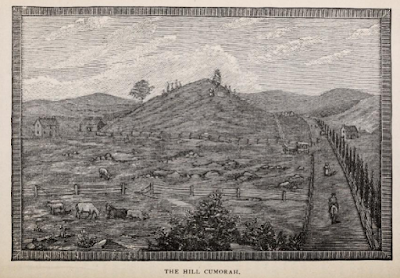
“Some people still dismiss David Whitmer’s account of the messenger taking the plates from Harmony to Cumorah before arriving in Fayette with the plates of Nephi.
I discussed this in 2016, but there are a lot of new readers who probably missed those posts so I’m posting updated versions of them here.
Note on Cumorah, David Whitmer and Zina Young

I realize the topic of Cumorah has been discussed a lot lately, but there are still people who claim the founding prophets and their successors were wrong when they taught that the Hill Cumorah of Mormon 6:6 is in western New York. I’ve covered this topic in detail here. This post covers a new bit of information that’s always been available but a lot of people don’t know much about it.
If you’re new to this topic, it has to do with two of the Three Witnesses. Those who advocate the Mesoamerican/two Cumorah geography (M2C) reject Oliver Cowdery’s description of Cumorah in Letter VII. They also reject David Whitmer’s explanation of the first time he heard the word Cumorah (which he said was in June 1829, before he’d ever read the text, and he heard it from a heavenly messenger).
The rationale for rejecting David Whitmer’s testimony is that he supposedly never talked about it until 50 years after the fact, in interviews he gave to Edward Stevenson in 1877 and to Joseph F. Smith and Orson Pratt in 1878.
Here’s how one scholar articulated the argument:

“The earliest possible connection between the New York hill and the Book of Mormon Cumorah comes from an 1878 interview with David Whitmer by Orson Pratt and Joseph F. Smith,… This report [the Whitmer interview] would be much more conclusive had it not been recorded nearly fifty years later. The passage of time and the accepted designation of “Cumorah” as the name of the New York hill by the time of the recollection argue against the second-hand report from Whitmer as being a definitive statement.”
There are all kinds of logical errors in that statement, but I’ve addressed those before. Today, I want to point out something in the Stevenson statement, taken from his contemporaneous journal.
I obtained a copy of Stevenson’s journal recently and here’s what his entry says:

“I wish to mention an Item of conversation with David Whitmer in regard to Seeing one of the Nephites, Zina Young, Desired me to ask about it. David Said, Oliver, & The Prophet, & I were riding in a wagon, & an aged man about 5 feet 10, heavy Set & on his back, an old fashioned Armey knapsack Straped over his Shoulders & Something Square in it, & he walked alongside of the Wagon & Wiped the Sweat off his face, Smileing very Pleasant David asked him to ride and he replied I am going across to the hill Cumorah. Soon after they Passed they felt Strangeley and Stoped, but could see nothing of him all around was clean and they asked the Lord about it. He Said that the Prophet Looked as White as a Sheet & Said that it was one of the Nephites & that he had the plates.”*

Edward Stevenson was a general authority (one of the seven presidents of the Seventy). He was a well-known missionary (one of the MTC buildings is named after him). There’s no reason to doubt the credibility of his interview with David Whitmer.
What I find fascinating is that Zina Young asked Stevenson to ask David Whitmer about seeing one of the Nephites. That was the focus of the interview, not the Cumorah question.

This means that Zina had heard this story earlier.
Why Zina Young?
And when could she have heard it?
And from whom?
It could not have been from the interview with Joseph F. Smith, which occurred a year later.
Instead, the evidence indicates she heard it from David Whitmer directly!
Zina was born in 1821. Her family lived in Watertown, New York. In 1835, when she was 14 years old, two missionaries came to town: Hyrum Smith and David Whitmer. Hyrum baptized her on August 1, 1835. The family moved to Kirtland, and eventually to Far West, and then to Nauvoo along with most of the rest of the Saints. Zina married, had two children, and then also married Joseph Smith. After his death, she married Brigham Young. (That’s a topic for another day.)
David Whitmer left the Church in 1837-1838 and lived in Missouri for the rest of his life. Zina would have had no contact with him after about 1837, at the latest. If that’s the case, then she could only have heard the story from him between 1835 and 1837–just a few years after 1829, when David said the event happened.
Of course, modern Mesoamerican scholars will dispute this somehow, but the argument that David’s testimony is unreliable because it was 50 years late contradicts the Stevenson account.
Interestingly, Zina was also the one who inherited Joseph’s seer stone after Brigham Young died.
The simplest, historically justified explanation is that David told Zina and her family the story when he contacted them as a missionary. Zina remembered it and told Stevenson to ask David about it in 1877. Stevenson recorded it and wrote about it.
Then Joseph F. Smith asked David about it, and he reiterated his account of the event.
It’s not a 50-year-old story related from a feeble and tainted memory. It’s a retelling of an account related by a missionary to his investigators just a few years after the event. Other than to defend the M2C ideology, there’s no reason to cast doubt on the testimony of the Three Witnesses.
________________

The bottom line is this:
To accept M2C, you have to disbelieve two of the three main witnesses to the Book of Mormon: Oliver Cowdery and David Whitmer. The M2C advocates seek to persuade you these two men were not reliable witnesses when it comes to the issue of Cumorah being in New York.
By contrast, to accept the North American setting (Moroni’s America or the Heartland), you fully embrace what these two men said.
References: http://contentdm.lib.byu.edu/cdm/ref/collection/BYUIBooks/id/3527
*You can find this account in these references, although apparently not transcribed exactly: “Edward Stevenson Interview (1) 22-23 December 1877, Richmond, Missouri Diary of Edward Stevenson,” LDS Church Archives, Lyndon W. Cook, ed., David Whitmer Interviews, 1993, p. 13; also Dan Vogel, ed., Early Mormon Documents, 2003, vol. v, p. 30._____
More on David Whitmer, Zina Young, and Cumorah

(photo links to JSP)
This post offers more detail on David Whitmer and Zina Young.
I’ve had some feedback on the previous post that there is no evidence Zina had heard about David Whitmer’s Cumorah experience from David himself. It’s true we don’t have written evidence of when she heard the story or from whom, but Stevenson’s journal shows Zina had heard it from somewhere before Stevenson visited Whitmer. That’s why she told Stevenson to ask Whitmer about it. I imagine the conversation being something such as this:
Zina: “You’re going to visit David Whitmer?”
Stevenson: “I plan to. I hope he’ll see me.”
Zina: “Ask him about the Nephite he met.”
Stevenson: “He met a Nephite?”
Zina (nodding): “And he was carrying the plates to the hill Cumorah because Joseph didn’t want the responsibility. David, Joseph and Oliver Cowdery were riding in a wagon from Harmony to the Whitmer farm. He’ll tell you all about it.”
Stevenson: “Sounds interesting.”
Zina: “You should publish it when you get back.”
The M2C advocates who reject David’s testimony rely on the “late” retelling to Stevenson and Joseph F. Smith. Their objection is based on the premise that David’s experience hearing the term “Cumorah” for the first time occurred in 1829, but he did not tell the story before 1877. Certainly, 50 years after the fact could be considered late; each person has to assess that “lateness” in light of the detail of Whitmer’s account, the surprising and unusual circumstances (most people probably remember their first encounter with divine messengers), and the presence of Joseph and Oliver when the event occurred.
The Stevenson account undermines the “lateness” objection, however. Whether Zina heard the story directly from Whitmer in 1835, or heard it from someone else, the point is that she did hear it before Stevenson asked Whitmer about it. From his journal, we have to infer that Stevenson had not heard the story before.
There is no record of anyone knowing this story before Stevenson’s interview with David, except for Zina. So all the evidence we have suggests that before the interview, the only two people who knew the story were Zina and David (and Oliver and Joseph, if David’s testimony is to be believed, but Joseph and Oliver were dead by then).
And the only evidence we have of David and Zina interacting was when David and Hyrum Smith were missionary companions in 1835 in Watertown, NY, where Hyrum baptized her. [This is no minor point. David Whitmer didn’t go on a lot of missionary journeys. When you read Zina’s account, notice how she emphasizes how hard David worked to persuade her to get baptized. It seems reasonable to infer he tried everything he could, including his viewing of the golden plates as one of the Three Witnesses. In this context, his claim he saw one of the Nephites carrying the plates to Cumorah would naturally be another thing to bring up.
Later, Joseph F. Smith and Orson Pratt visited David Whitmer and elicited the same story from him. This suggests they first heard it when Stevenson published it (or told them about it).
Zina published an article, probably taken from parts of her journal we don’t otherwise have now, in the April 1893 issue of The Young Woman’s Journal. Titled “How I Gained my Testimony of the Truth,” the article gives details on how she joined the Church in 1835. It is available online here. In the next section, I show the relevant aspects of Zina’s article.
In the following summer Hyrum Smith and David Whitmer came to our house and stayed several days. Father and mother had been baptized in the April of that same year, but neither myself nor my sister were baptized.
David Whitmer persuaded me to be baptized while they were at our home, but some way I did not accept his offer. I had told my sister-in-law, Fanny Huntingdon, that when she was baptized I would go with her.
The morning for the departure of these men from our house arrived, and I had not as yet become a member of the Church. That morning, a short time before they were to start, Hyrum Smith’s cousin rode up with a message that they could not leave that day, as my brother Dimick and his wife Fanny, my dear sister-in-law, were desirous of being baptized.
That morning at prayers I had presented to me a heavenly vision of a man going down into the water and baptizing someone. So when this message came I felt it was a testimony that the time had come for me to receive baptism. Brother Hyrum Smith was mouth in prayer, and in my secret soul I had a wish that he should baptize me. I had refused the coaxing of Brother Whitmer, as I told myself, because mother and father were going away from home, and I had all the home cares on me, and I feared I would be tempted to speak crossly or say something I ought not to after so sacred an ordinance as that; but this strong testimony that the proper time had arrived I did not dare treat lightly.
As soon as I consented to go with my brother and sister-in-law David Whitmer began talking about performing the office for us. Happily for me, however, Brother Hyrum was chosen by the others to be the proper one and I added my preference to their words. Accordingly, we all went down to the water and were baptized by Hyrum Smith, and confirmed under the hands of Hyrum Smith and David Whitmer. [This was on August 1, 1835.]
Article by Jonathan Neville here
Why does Book of Mormon Central say a “messenger” is Moroni?
Edward Stevenson’s journal said, “And an aged man about 5 feet 10, heavy set, and on his back an old fashioned army knapsack strapped over his shoulders and something square in it, and he walked alongside of the wagon and wiped the sweat off his face, smiling very pleasantly. David asked him to ride and he replied, ‘I am going across to the Hill Cumorah.’ Soon after they passed, they felt strange and stopped but could see nothing of him-all around was clear. And they asked the Lord about it. He said that the Prophet looked as white as a sheet and said that it was one of the Nephites, and that he had the plates.” See Edward Stevenson, Journal, Dec. 23, 1877
See the title assigned to the painting by Book of Mormon Central as, “Mary Whitmer and Moroni” by Robert T. Pack (See picture below)
In the actual article below, Book of Mormon Central never mention the messenger as “Moroni”, just as “a messenger“. Why would they call this messenger Moroni? Take a look at the description of Edward Stevenson below. He says that David Whitmer identified the messenger as 5’10” and heavy set. Does that describe the Moroni we all know as described by Joseph Smith? NO!
https://knowhy.bookofmormoncentral.org/knowhy/what-does-mary-whitmer-teach-us-about-enduring-trials
Original source (Joseph F. Smith, 1918):

“In the middle of this prairie, all of a sudden, there appeared a man walking along the road, and David said he raised his hat and rubbed his brow, as if it were a little warm, and said good morning to them, and they said good morning. Oliver and David looked at each other and began to marvel and wonder: Where did he come from, what does it mean? David described him saying he had on something like an old-fashioned knapsack, but of course a little differently formed, right across his shoulders, and on his back he was carrying something of considerable weight.
“They looked round to Joseph inquiringly: What does it mean? And Joseph said, “Ask him to ride.” So David, who was teamster, asked him if he would get in and ride with them. He said, “No, I am just going over to Cumorah.” David said, “Cumorah? Cumorah? What does that mean?” He had never heard of Cumorah, and he said, I thought I knew this country all around here, but I never heard of Cumorah” and he inquired about it. While he was looking around and trying to ascertain what the mystery was the man was gone, and when he looked back he did not seem him any more. Then he demanded, “What does it mean?”
“Joseph informed him that the man was Moroni, and that the bundle on his back contained plates which Joseph had delivered to him before they departed from Harmony, Susquehanna County, and that he was taking them for safety, and would return them when he (Joseph) reached father Whitmer’s home. There was a long talk about this.”
To be sure, there is a discrepancy in the accounts about whether this messenger was Moroni or one of the Three Nephites, a topic I’ve discussed elsewhere, but there is complete consistency among all the accounts that the messenger was going to Cumorah.” Jonathan Neville
John C. Whitmer’s 1878 account
As recorded by Andrew Jenson (see his Latter-Day Saint Biographical Encyclopedia 1:283, Salt Lake City, Utah: 1901):

one of the Three Nephites?
“I have heard my grandmother (Mary Musselman Whitmer) say on several occasions that she was shown the plates of the Book of Mormon by a holy angel, whom she always called Brother Nephi. (She undoubtedly refers to Moroni, the angel who had the plates in charge.)”
Why would John C. Whitmer change his grandmother’s name for the messenger from Brother Nephi, to Moroni?

We think the messenger appearing at Joseph and David’s wagon, (picture left) and the same messenger that appeared to Mary Whitmer at her farm and the same messenger who knocked at the door of Zina to teach her about Christ, could very well be one of the Three Nephites named Brother Nephi, AND IT WASN”T MORONI!
You Choose!
More Information from Zina Huntington by Ryan and Anita Murdock below:
I read your blog this morning and have a bit more to add. Zina Diantha Huntington Jacobs Smith Young is my husbands 3rd great grandmother and was the wife of two prophets, sealed twice to Joseph Smith (once by her brother Dimmock, best friend of the prophet, and then again by Brigham Young, after he returned from England.) She later married Brigham for time only. The reason she was interested in the Three Nephites, is because the same one stopped by their family home in Watertown, Jefferson, NY and taught them the gospel of Jesus Christ. It is mentioned in the book 4 Zina’s about her mother Zina, herself, her daughter Zina and granddaughter Zina. The family was having what we might call a family home evening one night, discussing scriptures and playing music, when they had a knock at their door, and when opened, they found a man dressed in old fashioned clothes, who said that he usually takes sequestered paths. the mother of the family, Zina Baker Huntington, had said she wished she could hear the gospel from someone who KNEW CHRIST. The man told them all about Jesus Christ in a manner that they had never heard before, as if he did know Christ, and stayed the night with them. Later after they were gathered with the Saints, William Huntington related the story to Joseph, who asked them the describe the man, which he did. Joseph confirmed it was one of the three Nephites sent to prepare them to receive the gospel. Since Zina had spent an entire evening with one of the three Nephites, not a moment, but an entire night learning from him, you can imagine why she was so interested in this story. -Anita Murdock


